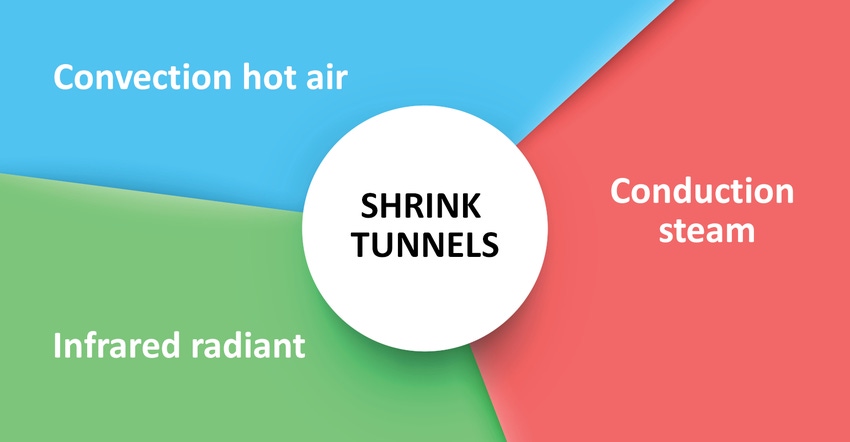Which Shrink Tunnel is Best for Your Labeling Operation?
What are the pros and cons of different shrink tunnel technologies? Is convection hot air, infrared radiant, or conduction right for your latest packaging application?
November 25, 2020

The shrink-sleeve label market is booming, thanks in part to how well this type of full-body packaging decoration appeals to consumers. Growth is anticipated to exceed 6% compound annual growth rate (CAGR) in the next five years, according to multiple research reports. This is driving innovations in associated packaging machinery, such as labeling machines (see the recent article, “Shrink Label Applicators: What’s New and What’s Next”).
Another system you’ll need for a shrink-sleeve labeling operation is a shrink tunnel. Do you know what to look for?
Here is a rundown of the three main types of shrink tunnels — convection hot air, infrared radiant, and conduction — courtesy of Richard Howlett, product line leader for Accraply, a Barry-Wehmiller Packaging Co. Howlett shares insights to help guide you past the pitfalls of each technology and make the best choice for your packaging application.
Hot-air (convection) tunnels.
Hot-air tunnels are versatile and cost effective to use. They connect to almost any power source. Hot air tunnels offer directional heat. Therefore, depending on the type of equipment used, the many different manifolds in these systems enable heat to be focused on those areas of the container that require the most shrinkage. This makes them good systems for focused heating on necks, recesses, and grooves.
Hot air tunnels do have some disadvantages. Hot air is not a very efficient medium through which heat is transferred. Therefore, temperatures in hot air tunnels are generally higher to enable enough heat to be transferred onto the surface of the film to start the shrink process. With hot-air systems, heat can sometimes be over-exposed to the leading edge of the container/sleeve, resulting in distortion and producing a poor-quality finish. This is particularly prevalent with certain container types and process conditions.
Examples of this may be a cold-filled plastic container, or glass containers. One way to mitigate this issue is to rotate the container as it passes through the tunnel using a “spinning” conveyor.
Radiant-heat (infra-red) tunnels.
Radiant-heat tunnels were primarily designed for preheating containers — prior to sleeving — to mitigate the heat-sink effect of glass containers. However, they can also be effectively used to shrink sleeves. Radiant systems deliver infrared heat, and, because the heat remains in the chamber, they create an oven-like shrinking environment.
Because of their high temperatures, radiant heat tunnels represent a harsh shrinking environment with little opportunity to direct heat toward specific areas on a container. Additionally, it can be particularly difficult to get even shrink results. For example, the leading side of the sleeve entering the tunnel gets aggressively shrunk before the trailing edge; or, the sleeve on the two sides of the container are exposed to more intense heat than the leading and trailing sides — again resulting in a “pulled” or uneven finished shrink sleeve.
A further complication of the high temperatures in radiant tunnels is the difficulty they can present with empty containers. For example, the task of shrinking a polyethylene terephthalate gly (PETG) sleeve on a thin-wall, empty polyethylene terephthalate (PET) container can be extremely challenging in a radiant tunnel.
Steam (conduction) tunnels.
Steam tunnels are the preferred medium for most applications. They offer some significant advantages in terms of the process window. It is the most versatile type of tunnel and works well for a variety of films.
Steam distributes heat evenly to the entire surface of the film as it envelopes the container passing through the tunnel. And, because it is steam — and water is more than 20 times more efficient at transferring heat than is air — temperatures are lower and the environment in the tunnel much less harsh.
Despite steam tunnels being the most favored method of shrinking shrink-sleeve labels due to their propensity to deliver the most even finished result, their initial installation is likely to be more involved and expensive than other technologies. This is due to the need for a steam-generating boiler, as well as all the associated piping, extraction, valve gear, and drainage required. The volume of steam, and hence the boiler requirements, will primarily be dictated by the volume of throughput required of the sleeving line.
About the Author(s)
You May Also Like


